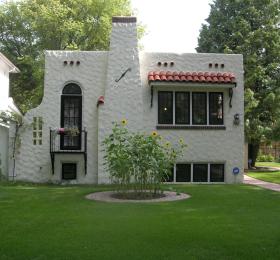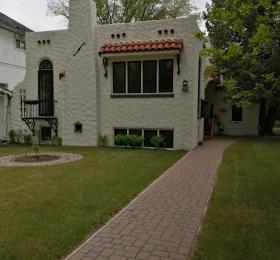W. J. English House
- Designated
Description of the Historic Place
The W.J. English House is a raised bungalow, with an eclectic style, that was constructed in 1931.
The house is located at 932 University Drive in the neighbourhood of Nutana, and was designated as a Municipal Heritage Property in 2012. Designation is limited to the exterior of the house.
Heritage Value
The heritage value of the W.J. English House is its eclectic architectural style, with its unique blend of Spanish and California Mission styles. The house was designed by the architectural firm of Webster and Gilbert for Mr. and Mrs. Walter English. This architectural firm designed other buildings of this style including the Little Chief Service Station, and McGavin’s Bakery (Earl’s Restaurant) among others.
The heritage value of the W.J. English House also lies in its association with a number of prominent Saskatoon citizens. Walter English came to Saskatoon in 1910 to work for A.L. Charlebois. Mr. English formed his own roofing firm and operated it from 1926 to 1960. In 1948, Mr. Harry Charmbury purchased the house. Charmbury was a professional photographer who moved to Saskatoon from Prince Albert in 1918. Most of his work was portraiture, photographing First Nations Leaders, contracts for City Hall and many other groups and events. Charmbury did early forensic and police work and played a role in setting up the Saskatoon Police Identification Department.
In 1976, the house was purchased by Dr. J.W.T Spinks and his wife. Dr. Spinks came to Saskatoon in 1930 and was employed by the University of Saskatchewan as a chemistry professor. Dr. Spinks rose through the ranks and became President of the University of Saskatchewan in 1960. Throughout his career as a professor, researcher and university president, Dr. Spinks had many accomplishments and received many accolades. He was appointed a companion to the Order of Canada in 1970 and in 1985 was named Saskatoon’s Citizen of the Year.
Source: City of Saskatoon Bylaw No.9079 / City of Saskatoon Built Heritage Database
Character Defining Elements
Key elements which contribute to the heritage value of this historic resource include:
- Its Spanish / California Mission architectural style, evident in: its stucco exterior, clay tile roof, arched windows, wrought iron grillwork and railings, and the sunken patio.
- Those features that relate to its historical significance including its location on its original lot along University Drive.


